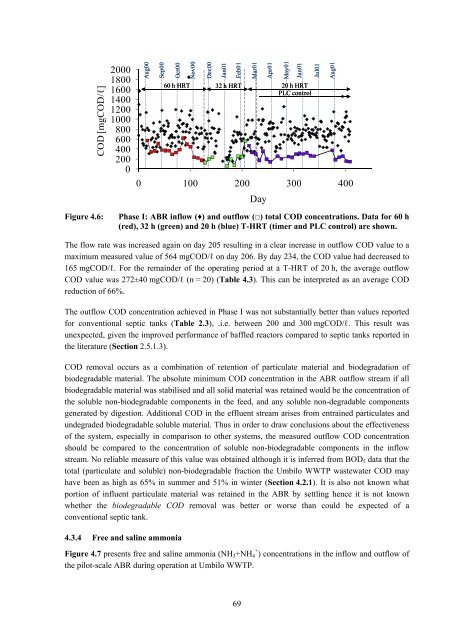analysis of a pilot-scale anaerobic baffled reactor treating domestic ...
analysis of a pilot-scale anaerobic baffled reactor treating domestic ...
analysis of a pilot-scale anaerobic baffled reactor treating domestic ...
You also want an ePaper? Increase the reach of your titles
YUMPU automatically turns print PDFs into web optimized ePapers that Google loves.
COD [mgCOD/ℓ]<br />
2000<br />
1800<br />
1600<br />
1400<br />
1200<br />
1000<br />
800<br />
600<br />
400<br />
200<br />
0<br />
Aug00<br />
Sep00<br />
Oct00<br />
Figure 4.6: Phase I: ABR inflow (♦) and outflow (□) total COD concentrations. Data for 60 h<br />
(red), 32 h (green) and 20 h (blue) T-HRT (timer and PLC control) are shown.<br />
The flow rate was increased again on day 205 resulting in a clear increase in outflow COD value to a<br />
maximum measured value <strong>of</strong> 564 mgCOD/ℓ on day 206. By day 234, the COD value had decreased to<br />
165 mgCOD/ℓ. For the remainder <strong>of</strong> the operating period at a T-HRT <strong>of</strong> 20 h, the average outflow<br />
COD value was 272±40 mgCOD/ℓ (n = 20) (Table 4.3). This can be interpreted as an average COD<br />
reduction <strong>of</strong> 66%.<br />
The outflow COD concentration achieved in Phase I was not substantially better than values reported<br />
for conventional septic tanks (Table 2.3), .i.e. between 200 and 300 mgCOD/ℓ. This result was<br />
unexpected, given the improved performance <strong>of</strong> <strong>baffled</strong> <strong>reactor</strong>s compared to septic tanks reported in<br />
the literature (Section 2.5.1.3).<br />
COD removal occurs as a combination <strong>of</strong> retention <strong>of</strong> particulate material and biodegradation <strong>of</strong><br />
biodegradable material. The absolute minimum COD concentration in the ABR outflow stream if all<br />
biodegradable material was stabilised and all solid material was retained would be the concentration <strong>of</strong><br />
the soluble non-biodegradable components in the feed, and any soluble non-degradable components<br />
generated by digestion. Additional COD in the effluent stream arises from entrained particulates and<br />
undegraded biodegradable soluble material. Thus in order to draw conclusions about the effectiveness<br />
<strong>of</strong> the system, especially in comparison to other systems, the measured outflow COD concentration<br />
should be compared to the concentration <strong>of</strong> soluble non-biodegradable components in the inflow<br />
stream. No reliable measure <strong>of</strong> this value was obtained although it is inferred from BOD5 data that the<br />
total (particulate and soluble) non-biodegradable fraction the Umbilo WWTP wastewater COD may<br />
have been as high as 65% in summer and 51% in winter (Section 4.2.1). It is also not known what<br />
portion <strong>of</strong> influent particulate material was retained in the ABR by settling hence it is not known<br />
whether the biodegradable COD removal was better or worse than could be expected <strong>of</strong> a<br />
conventional septic tank.<br />
4.3.4 Free and saline ammonia<br />
Nov00<br />
Dec00<br />
Jan01<br />
Feb01<br />
0 100 200 300 400<br />
Figure 4.7 presents free and saline ammonia (NH3+NH4 + ) concentrations in the inflow and outflow <strong>of</strong><br />
the <strong>pilot</strong>-<strong>scale</strong> ABR during operation at Umbilo WWTP.<br />
69<br />
Mar01<br />
Day<br />
Apr01<br />
May01<br />
Jun01<br />
60 h HRT 32 h HRT 20 h HRT<br />
PLC control<br />
Jul01<br />
Aug01<br />
0.5
















